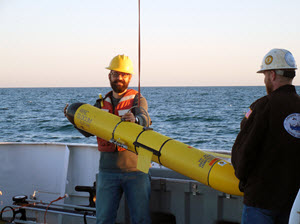
Adam Boyette retrieves a glider on the deck of the R/V Point Sur, where he served as chief scientist on the three-day cruise examining the impacts of the Bonnet Carré spillway opening. (Photo by Alison Deary)
Microscopic organisms called plankton, an important component of the marine food web, congregate in the freshwater-laden coastal waters of the northern Gulf of Mexico. Adam Boyette wants to learn more about how and where these plankton live to better understand how an oil spill or other disaster might impact their populations.
He is collaborating with other scientists to show how the near-coastal environment interconnects with the larger world around it.
Adam is a GoMRI Scholar with CONCORDE working towards a Ph.D. in marine science at the University of Southern Mississippi (USM). He discusses his journey from the Mississippi Delta to the coastal Gulf he now calls home.
His Path
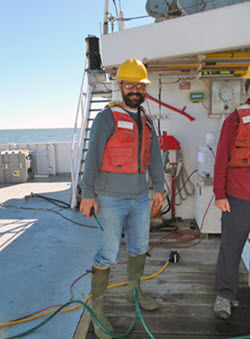
Adam stands by on the deck of the R/V Point Sur to retrieve the CTD rosette. (Photo by Alison Deary)
Adam grew up in a rural town at the heart of the Mississippi Delta, an area made famous by Muppets-creator Jim Henson and blues music. He spent his childhood outdoors collecting insects and snakes, fishing, and exploring the Delta’s rich ecology.
His first visit to the Florida panhandle at age eight sparked a life-long love of the ocean that would eventually steer his future.
Adam did not begin college immediately after high school. Instead, he worked on Mississippi River tow boats and in catering kitchens, discovering new interests and skills in every job. He would earn a bachelor’s degree in marine biology at USM more than ten years after he graduated from high school, immediately complete a master’s degree in marine science, and then move on to his Ph.D.
“I had this unfulfilled yearning to do something meaningful, something where I could contribute,” Adam said, explaining that living through the one-two punch of Katrina and the oil spill deeply affected him. “You want to be part of something bigger than you are. I knew without a doubt that I wanted to be a marine scientist.” Adam joined several research cruises while working as a graduate assistant for ECOGIG co-principle investigator Vernon Asper, including the successful effort to rescue the downed AUV Mola Mola. Familiar with GoMRI’s mission, he jumped at the chance to join CONCORDE director Monty Graham’s lab when the consortium formed in 2015.
His Work
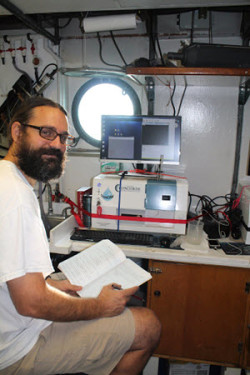
Adam takes notes in the R/V Point Sur’s lab while his FlowCam analyzes samples. (Photo by Alison Deary)
Adam studies the thin layers of plankton common in the coastal Gulf of Mexico water column. He measures the plankton’s photosynthesis processes to better understand their uptake and primary production rates of carbon. He also investigates how frequently other organisms, namely predatory microzooplankton, graze on these plankton concentrations. This information will help researchers understand how pollutants like oil move through the area and what living creatures they impact.
Adam collects seawater within the Mississippi Bight, a coastal environment dominated by river water plumes that mix and merge with the salty Gulf. He has joined other CONCORDE scientists on three larger research cruises and sampled on his own in small crafts. “When I’m not actually on a research cruise, I’m either preparing to go on one or analyzing data from a previous one,” he laughed.
Adam determines carbon uptake rates in his samples using an incubator called a photosynthetron, which simulates the in situ light environment and uses the resulting vertical light gradient to measure photosynthetic rates. He uses this information to calculate plankton’s carbon production and uptake and to estimate changes in phytoplankton abundance and growth over a 24-hour period.
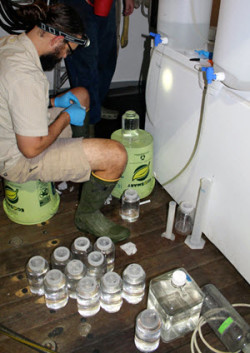
Adam works on dilution experiments during the early morning hours of a cruise. (Provided by Adam Boyette)
He also conducts experiments to examine grazing rates for microzooplankton feeding on phytoplankton. Then, he runs the samples through a particle imaging device called a FlowCAM to identify organisms in the water, allowing him to determine how many and which plankton and predatory microzooplankton species live in his study area.
Adam uses this information to understand the dynamics of nearshore microbial populations during various seasons. His calculations will be incorporated into a large ecological model that CONCORDE scientists are creating to represent the physical, chemical, and biological processes in the nearshore environment. “My motivation is to understand the connectivity between all things, to show how delicate the interplay is between the world we see and the microbial world,” he explained. “It’s a personal fascination.” Adam’s raw data collected through his CONCORDE research are available through the Gulf of Mexico Research Initiative Information and Data Cooperative (GRIIDC).
His Learning
“As Dr. Graham’s student, I’ve learned a lot about working collectively to achieve a common goal,” Adam said. “He’s provided wonderful leadership opportunities for emerging scientists to learn and grow.” One such opportunity came earlier this year, when Adam served as the chief scientist on an emergency three-day multi-consortia cruise to study the Bonnet Carré spillway opening, an action taken to protect New Orleans from rising Mississippi River floodwaters that sent millions of gallons of freshwater into the northern Gulf. He and other GoMRI scientists attending the Gulf of Mexico Oil Spill and Ecosystem Science Conference discussed how the unusual event might impact their study areas and planned the cruise.
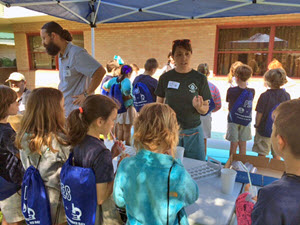
Adam and fellow graduate student Naomi Yoder teach Pontchartrain Elementary students about nearshore ecology during an Earth Science Day event. (Photo by Stephanie Watson)
The cruise included scientists from CONCORDE, DEEPEND, ECOGIG,CARTHE, and ACER. Adam took pleasure in seeing the process through from its somewhat chaotic inception to a highly organized research event, drawing on his experiences working in professional kitchens to keep everything running smoothly. The array of cross-disciplinary GoMRI scientists also helped make the project a success. “The most important thing I learned from this experience was to let go,” Adam said of his chief scientist position. “Put your trust in people and don’t try to be in control of everything. Instead, work with everyone and utilize their expertise – these people are here for a reason.”
His Future
Adam plans to finish his doctoral program in May 2018. He wants to continue researching plankton ecology using technologies such as satellite imaging and the FlowCam. His dream is to become an ongoing water quality project manager working for government agencies such as NOAA or the EPA or in a postdoctoral role at a university. “The oil spill has really shown the importance of long-term datasets,” Adam said.

Adam and fellow USM student Liesl Cole work in the R/V Point Sur’s highly secure radioisotope lab (known as the “rad van”) during the CONCORDE Spring Campaign. (Photo by Heather Dippold)
Praise for Adam
Monty Graham serves as both CONCORDE’s principle investigator and the Director of USM’s School of Ocean Science and Technology. He stated, “I can attest to Adam’s maturity, leadership potential, technical skills, and motivation and am thrilled that he is being recognized for his efforts.” Graham called Adam a critical member of the CONCORDE project, “He has been the student that his peers look up to, and a student that my research colleagues seek for advice. He pursues every opportunity to increase his knowledge within his chosen field, and has learned new technologies that are going to be applied widely in our studies.”
Graham explained that Adam shines in leadership roles, receiving “stellar reviews” from everyone involved in the Bonnet Carré cruise. “He has led his fellow students through trainings and scientific discussions and he is respected by his peers and senior scientists alike,” said Graham. “He is an excellent addition to the GoMRI Scholar program and is the definition of student success.”
The GoMRI community embraces bright and dedicated students like Adam Boyette and their important contributions. The GoMRI Scholars Program recognizes graduate students whose work focuses on GoMRI-funded projects and builds community for the next generation of ocean science professionals. Visit the CONCORDE website to learn more about their work.
************
This research was made possible in part by a grant from The Gulf of Mexico Research Initiative (GoMRI). The GoMRI is a 10-year independent research program established to study the effect, and the potential associated impact, of hydrocarbon releases on the environment and public health, as well as to develop improved spill mitigation, oil detection, characterization and remediation technologies. An independent and academic 20-member Research Board makes the funding and research direction decisions to ensure the intellectual quality, effectiveness and academic independence of the GoMRI research. All research data, findings and publications will be made publicly available. The program was established through a $500 million financial commitment from BP. For more information, visit http://gulfresearchinitiative.org/.
